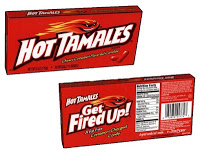I have been getting acquainted with Professor Interrante's project and learning more about the specific goals. I'm working with another DREU student, Haley, who has been here for five weeks already, so she's been filling me in on the current state of the virtual grocery store. The program was moved to OGRE, an opensource 3D graphics engine, so a big challenge is going to be reorganizing the groceries without the use of a graphical user interface.
Week Two:
Many of the original groceries are labeled in Italian, which makes it difficult to navigate through the store and detracts from the goal of creating a realistic environment for the people that will be tested. A lot of time this week has been spent translating and editing some of the existing texture files and creating new 3D groceries using Google SketchUp to repopulate the shelves.
 |
| Hot Tamales® candy for use as a filler item |
 |
| Advil® PM for the pharmacy shelves |
We are finalizing some of the larger edits in the store and will finish filling the shelves pretty soon. After brainstorming ways to test the different types of neurocognitive processes, we began implementing the methods within the virtual environment by ensuring all the necessary tools are installed. For example, one of the main distractors in the store will be a "blue-light special" that indicates a short-term sale on a specific item. This requires the addition of a light fixture in the store, as well as aisle markers that indicate where items are located.
Week Four:
One of the biggest obstacles in reorganizing the virtual grocery store has been the fact that OGRE has no graphical user interface. In the original store, the items were added in a drag-and-drop style. In OGRE, each item has a 4x4 matrix of coordinates which was a little intimidating at first. This week has been spent learning how the axes are oriented and becoming more familiar with manipulating objects in the coordinate system.
Week Five:
Last week, we started replacing old items on a few of the shelves. The challenge this week is to finish replacing items while making sure to include any items that might be used during testing. For example, if the task is to purchase items for a barbecue, there must be plastic cutlery, paper plates, cups, etc. It is so exciting to see the virtual environment look more like a grocery store every day!
Week Six:
This is Haley's last week here, so she has been walking me through some of the OGRE tutorials that she did in her first weeks here. We've also been frantically replacing groceries so we can try to implement some of our tasks before we run out of time in the lab. We have been collaborating with Vicki to decide on our final tasks so that we can make sure that we have all of the items we need, especially some of the more obscure things like paper cups, plastic cutlery, and a blue light.
Week Seven:
Vicki is at a conference and Haley went home, so the lab is a little lonely this week. I ran into some errors while setting up my computer to run the OGRE tutorials, but they seem to be running fine now. Since we were working with existing code, I didn't have to know much about how OGRE works to be able to work with the program over the past several weeks. However, in order to implement some of the specific tasks, I needed to learn more about how OGRE organizes things.
Week Eight:
Last week I learned a lot of the basics about OGRE, like how scenes are constructed and how to set up different cameras. After talking to Vicki, I'm realizing that I won't have enough time to fully implement the blue-light task that we planned, but I've been having a lot of fun learning about the different graphics programs. We decided that my time would be better spent this week making sure that all the files on my personal computer were coordinated with the lab computers and that everything was updated to the final versions.
Week Nine:
This week is definitely bittersweet. I'm excited to go back home to Kansas for the weekend (before school starts back up here), but I will miss working on the project. I am spending this week tying up the rest of the loose ends so things are as organized as possible for the next students who work in the lab, who will hopefully enjoy it as much as I have. I'm a little disappointed that I didn't get everything done that I wanted to, but I'm happy that the next person to take on this project will have a beautiful and organized store to work with.